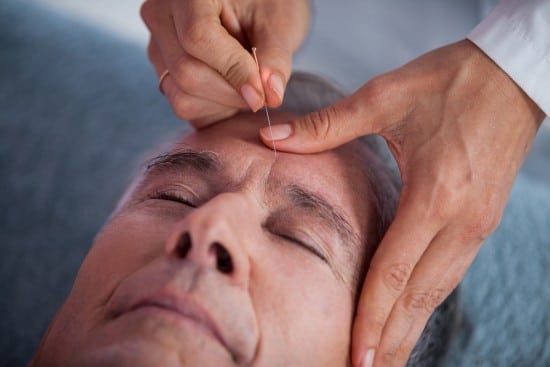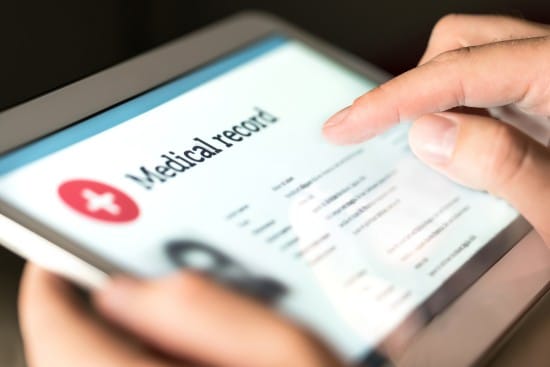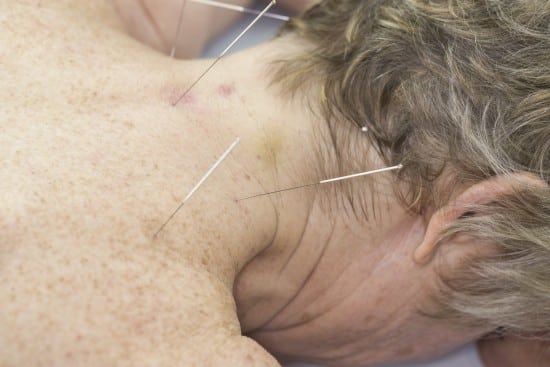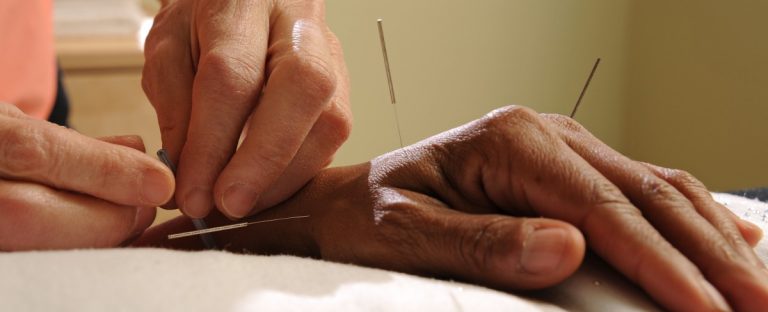In the enduring fight to reduce the severity of opioid addiction, traditional and holistic approaches continue to overlap and present alternative methods for treating chronic ailments and improving mental health. One significant treatment that is a proven opioid alternative is acupuncture.
Acupuncture has its origins in traditional Chinese medicine and recent studies over the last few decades prove time and again its effectiveness in treating a variety of chronic pain conditions and more. In particular, acupuncture research has investigated its benefits for veterans—and the federal department of Veterans Affairs recently included acupuncture in its efforts to promote complementary and integrative health.
How did the VA come to this conclusion? And what does this relationship mean for your acupuncture practice and the veterans in your community? Keep reading to learn more about the history of acupuncture and the VA, plus some tips for billing the VA for acupuncture services provided to veterans.
Acupuncture & The VA: A Timeline
Let’s look at a brief timeline of acupuncture and the VA:
- 1998: The National Center for Complementary and Alternative Medicine (NCCAM) is established with the goal of rigorously testing the effectiveness of “alternative” medicines that existed outside the scope of traditional medicine
- 2005: The Institute of Medicine (IOM)—now known as the National Academy of Medicine (NAM)—reports on the relationship between “alternative” medicines and Americans partaking in them for their overall wellness; this report encourages educational curriculum regarding “alternative” medicines be included in the medical field so traditional physicians can help their patients navigate these treatments
- 2014: Congress changes NCCAM’s name to the National Center for Complementary and Integrative Health (NCCIH), indicating a change in attitude towards “alternative” medicines as a more serious and important approach to health and wellness
- 2015: A report conducted by the Veterans Health Administration (VHA) Healthcare Analysis and Information Group recognizes acupuncture as one of the most common complementary treatments, further validating acupuncture’s role in treating a variety of ailments
- 2017: VA Directive 1137 – Provision of Complementary and Integrative Health is approved, which establishes national VHA policy regarding the provision of CIH approaches; this includes acupuncture as a vetted and recognized complementary treatment for veterans
Evidence of Acupuncture’s Benefits for Veterans
The VA found that acupuncture provides numerous benefits to common ailments and conditions that veterans must live with, including:
- Lower Back Pain: A 2012 analysis of data on participants in acupuncture studies found that actual acupuncture was more helpful than either no acupuncture or placebo acupuncture
- Mobility: A 2008 study found that there was a significant improvement in mobility for patients with osteoarthritis of the knee when acupuncture treatments were included in their wellness plan
- PTSD: According to research published by the National Center for Biotechnology Information (NCBI), acupuncture can affect the autonomic nervous system, and the prefrontal as well as limbic brain structures, making it able to relieve the symptoms of PTSD

5 Steps for Billing VA for Acupuncture Treatments
The medical billing process for the Veterans Affairs department requires a few steps to accurately bill them and develop a relationship with them along the way; start with these foundational steps:
Acquire Your National Provider Identifier (NPI)
The first step to billing the VA for acupuncture is to acquire a National Provider Identifier (NPI). A National Provider Identifier, or NPI, is a 10-digit identification number issued to healthcare providers in the U.S. by the Centers for Medicare and Medicaid Services. Your acupuncture practice will need to apply for an NPI if you are a HIPAA-covered health care provider or if you bill insurance for your services.
Establish Your Community Care Network Region
The VA Community Care Network (CCN) is divided into six regions that cover the continental United States in addition to Hawaii, the Caribbean, and the Pacific Islands. TriWest manages the western networks while Optum handles the eastern regions. Find out which region your acupuncture practice resides in.
Get Credentialed in Your CCN Region
In order to provide great care for veterans at your holistic practice with acupuncture services, you’ll need to be credentialed with the region’s third-party administrator. This process typically takes at least three months to complete. Depending on your region, contact the following to get started with the credentialing process:
- Region 1: 888-901-7407 (Optum)
- Region 2: 844-839-6108 (Optum)
- Region 3: 888-901-6613 (Optum)
- Region 4: 866-286-4174 (Triwest)
- Region 5: 877-226-8749 (Triwest)
The VA has not officially contracted with an agency for Region 6; contact information is pending for that region.
Fill Out Registration Paperwork
Upon completing the credentialing process with your region’s third-party administrator, you’ll need to submit the necessary paperwork to become fully registered with the VA’s Community Care Network. This paperwork is submitted electronically and will include details regarding any final requirements that must be met in order to finish the credentialing process for your acupuncture practice.
Begin to Receive Patient Authorizations
Once your holistic practice has been verified and authorized by the VA’s network, you’ll start to receive referrals to treat veterans who are approved to start acupuncture treatments. Your CCN administrator will provide the patient’s authorization letters before the patient’s first visit to your acupuncture practice.
After completing these important foundational steps, you’re ready to start billing the VA and treating veterans in your community!
When submitting an insurance claim to the VA for the first time, you’ll need to submit all the authorization letter pages together with the claim. Make sure you transmit all the following information with your acupuncture services claim to avoid a denial:
- A cover letter
- The date range for services
- Authorization numbers
- The total number of visits authorized
- The patient’s demographics including address, date of birth, and social security number
- Documentation and CPT codes of treatments administered
By following this checklist, you can ensure your Veterans Administration insurance claim will have all the accurate information it needs for a smooth billing process.
Want to streamline your acupuncture practice’s overall revenue cycle? Partner with Holistic Billing Services to optimize your medical billing and coding processes, minimize your rejected claims, and instantly improve your revenue cycle. Our experts have experience in your specialty and we’re eager to help your holistic practice.
As the healthcare industry continues to fight the opioid epidemic and encourage the use of drug-free alternatives to managing pain and other chronic conditions, it’s important to also expand coverage to enable such movements to spread. Particularly, expanding chiropractic Medicare billing coverage is a vital effort to improve access to drug-free alternatives for seniors covered by this government program.
One recent initiative to expand drug-free coverage under Medicare is the Chiropractic Medicare Coverage Modernization Act proposed by New York Congressman Brian Higgins and championed by the American Chiropractic Association. Officially filed as H.R. 2654, this legislation would significantly improve access to chiropractic treatments and other related drug-free services.
A Look at the Chiropractic Medicare Coverage Modernization Act (H.R. 2654)
The Chiropractic Medicare Coverage Modernization Act (HR 2654) would enable patients under Medicare coverage to visit a chiropractor for their comprehensive services. Such services might include manual manipulation of the spine and extremities, evaluation and management of conditions, diagnostic imaging, and the utilization of other non-drug treatments in an effort to combat prescription abuse and fight the opioid epidemic.
Essentially, this bill:
- Provides patient access to all Medicare-covered benefits as delivered by a chiropractor’s state licensure
- Categorizes a Doctor of Chiropractic (DC) as a “physician” in Medicare’s programming and thus expand their authority as recognized by Medicare
- Requires that DCs complete a documentation webinar
- Has bipartisan support and was introduced by 16 cosponsors from both sides of the political aisle
As a side note, the component regarding completing a documentation webinar means that DCs would be required to participate in a webinar that explains how to include proper documentation for billing Medicare. The medical billing and coding process is rather intricate, so mandating a webinar regarding appropriate documentation for billing Medicare would help inform DCs on the process and, ideally, reduce the number of claims filling inaccurately or incompletely.
Overall, this piece of legislation would grant significantly more access to all services provided by a chiropractor and thus empower chiropractors to treat a new population of patients who are covered by Medicare.
Fighting the opioid epidemic doesn’t happen overnight, nor can it be comprehensively addressed with just a single Act, but every little bit counts. Radically expanding chiropractic Medicare coverage for millions of people is one important step to encouraging drug-free alternatives to pain and ailment management plans.
Current Chiropractic Medicare Billing Coverage
The relationship between chiropractic coverage and Medicare has existed for decades—50 years, in fact.
The field of chiropractic medicine was established in the late 19th-century by Daniel David Palmer; the first chiropractic treatment occurred when Palmer noticed his building’s janitor, who was hard of hearing, had a vertebra out of place. Upon manipulating the vertebra back into place, the janitor’s hearing improved and the rest is history. Manual manipulation of the spine, joints, and holistic body has a long tradition of improving overall health and continues to be a cornerstone alternative to prescription drugs.
Let’s briefly outline the history of chiropractic coverage in relation to federal or national recognition:
- 1972: Medicare introduces chiropractic coverage under the limited scope of spinal manipulation
- 1974: Chiropractic treatments are included as part of the Federal Employees Health Benefits Program
- 1993: Congress passes legislation that includes chiropractic medicine in the US Department of Defense healthcare system
- 1999: Legislation passes to include chiropractic care in the Veterans Affairs healthcare system
- 2014: The VA launched a chiropractic residency program, the first of its kind in the country, where chiropractors train alongside their medical counterparts at VA medical systems around the country
- 2019: H.R. 3654 is introduced to the 116th session of Congress by two New York Congressmen, Brain Higgins and Tom Reed, which would expand coverage of Medicare to include comprehensive services as delivered by a licensed chiropractor; the Bill garners 90 cosponsors but ultimately does not pass before the end of that Congressional session
- 2021: H.R. 2654 is re-introduced by Brian Higgins to the 117th session of Congress and is presented with 16 bipartisan sponsors, which is promising to the future of the Bill; the legislation is the same as the original H.R. 3654 bill
With support from the ACA and chiropractors around the country, H.R. 2654 has a strong chance to pass in this session of Congress and greatly expand coverage of chiropractic services for millions of patients.

Benefits of Chiropractic Treatment
Chiropractic treatment has been proven to deliver several benefits, including:
Proven Alternative to Prescription Opioids
A recent study conducted in 2020 examined two groups of more than 100,000 people total between the ages of 18 and 84: one group, who went to their doctor alone for managing their pain, and another group who received primary care and chiropractic care.
The study found that those who visited a chiropractor in addition to their primary physician were less likely to be prescribed opioids to manage their pain—in fact, they had half the risk of being prescribed opioids. These findings are significant because it proves that chiropractic treatment is an effective and safe drug-free alternative to managing chronic pain, temporary ailments, and more.
Reduces Chronic Back Pain
Of the 22 million people who seek chiropractic treatment any given year, nearly 8 million of them are seeking relief from chronic back pain. Whether caused by an athletic injury, a car accident, a muscle strain, or something else, chiropractic treatment is effective at managing chronic back pain.
Improved Range of Motion
Routine, consistent chiropractic treatments result in an improved range of motion. Chiropractic treatment reduces inflammation, aids in blood flow, and ensures that your spine and joints are in their optimal positions to enable smooth movement. Increasing your range of motion means that regular activities require less effort on your part!
Optimize Your Chiropractic Medicare Billing Cycle with Holistic Billing Services!
Medicare’s expansion to further include comprehensive chiropractic care would provide a huge benefit to your chiropractic practice and could bring in a whole new group of potential patients; how exciting! Want to optimize your practice’s revenue cycle? Partner with an expert medical billing firm that has specialized expertise in handling chiropractic billing and Medicare experience.
At Holistic Billing Services, we deal exclusively with holistic healthcare practices that deliver acupuncture, massage therapy, and chiropractic treatments to communities around the country. Whether you have questions on chiropractic insurance billing or other methods to enhance your revenue cycle management, feel free to contact our team today and let us know how we can help your practice today!
At Holistic Billing Services, we know that trying to make sense of the medical billing cycle can be confusing and intimidating. There are so many acronyms to learn and putting the pieces of the massive puzzle can feel impossible; we’re here to help break down the process and explain some of the acronyms involved. In particular, the Centers for Medicare and Medicaid Services (CMS) has an intricate methodology to determine physician payment.
Their methodology, the Resource-Based Relative Value Scale (RBRVS), is also used by some private payer entities, so understanding how the RBRVS and its basic unit, the Relative Value Unit (RVU), impacts your holistic practice’s revenue cycle and the Medicare billing process is helpful to know a component of your practice’s finances.
What Is a Relative Value Unit?
A relative value unit (RVU) defines the value of a service or procedure in relation to all other services or procedures. This measure is based on the extent of physician work, clinical and non-clinical resources, and expertise required to deliver the healthcare service to patients. It’s important to note that RVUs don’t directly represent the payout for a physician’s services but are a relevant factor in helping CMS determine that figure.
Why Are RVUs Important to Understand?
From one perspective, anything to do with your financial bottom line is important to understand—therefore understanding what relative value units do and their role in Medicare billing is helpful for evaluating your revenue cycle and anticipating future changes.
CMS operates under the rule of budget neutrality—that means that if one area’s rate goes up, a rate in a different area goes down. Since RVUs and their physician fee schedule are updated every year and liable to have some changes, it’s helpful to recognize the role that RVUs play in these changes so that your holistic practice can anticipate them.

What Is the Role of RVUs in a Physician Fee Schedule?
The Medicare physician fee schedule (MPFS) outlines more than 10,000 physician services, their associated relative value units, miscellaneous payment policy information or contexts, and more. The pricing amounts included in the MPFS are adjusted regarding the geographic region and other factors that are taken into account.
As a whole, under the resource-based relative value system (RBRVS), physician payments are determined by the following factors:
- RVUs
- Geographic Practice Cost Indices (GPCIs)
- Conversion Factor (CF)
An RVU is comprised of three components: work, practice expense, and malpractice. The work RVU reflects the general time and intensity associated with the service or procedure; the practice expense component reflects the cost of owning and operating a practice, such as renting space, practice equipment, and more; the malpractice RVU reflects the cost of malpractice insurance.
CMS adjusts the cost of each relative value unit in relation to the geographic practice cost index, which essentially factors in the cost of living depending on the location of the practice.
Finally, the conversion factor is updated by CMS every year and translates RVUs into dollar amounts.
The final equation for all of this results in the following:
Payment = (Work RVU + Practice Expense RVU + Malpractice RVU) x Conversion Factor
Overall, relative value units play a critical role in the equation that CMS and commercial fee systems utilize to establish the Medicare physician fee schedule.
How Do RVUs Impact Medicare Billing?
If your holistic practice is providing quality care and treatments to patients covered by Medicare, then it’s vital to gain a foundational understanding of how relative value units impact Medicare billing and thus a part of your finances:
Facilities and Non-Facilities Fees Differ
Payment rates for facilities differ from those for non-facilities; facility fees cover hospitals and in-patient services or procedures whereas non-facility fees cover physician offices or other independent settings.
Be sure to utilize the CMS Physician Fee Schedule search feature to learn more about the differences in fees.
RVUs and Audits
Relative value units are helpful for Medicare and other private payer systems to gauge an estimate for how much your services cost based on your geographic location and the other aforementioned factors. As such, there’s a state and national norm for what your services cost—and if you’re found to be charging exponentially higher than your competitors, then it could raise a red flag. In this case, you might be audited to see what’s going on.
Inaccurate Medical Coding and Billing Has Consequences
Since every service you provide to patients covered by Medicare has a correlating relative value unit and associated code, it’s vital that you submit accurately coded claims to Medicare for your services. Inaccurate billing can lead to an increased chance of audits and throws a wrench in your revenue cycle!
Partner with Holistic Billing Services to Handle Medicare Billing and Streamline Your Revenue Cycle!
Medicare billing and coding can be frustrating and overwhelming to deal with, especially if your internal resources are already stretched thin. That’s why partnering with a medical billing firm is proven to significantly optimize your revenue cycle and ensure that your practice is always up to date on current regulations and fee schedules.
At Holistic Billing Services, we deal exclusively with holistic healthcare practices that deliver acupuncture, massage therapy, and chiropractic treatments to communities around the country. Whether you have questions on private insurance billing or Medicare billing to enhance your revenue cycle management, feel free to contact our team today and let us know how we can help your holistic practice.
Did you know that healthcare data breaches cost US industries $6.2 billion per year? With such a high cost, it’s more critical than ever to ensure that your holistic practice is taking the best steps possible to avoid a breach and safeguard your patients’ information.
One critical method for ensuring the privacy and safety of your patient’s sensitive information is to maintain compliance with the HITECH Act, which streamlines operations and keeps your holistic practice secure.
What Is the HITECH Act?
The Health Information Technology for Economic and Clinical Health Act (HITECH Act) was signed into law as part of the American Recovery and Reinvestment Act (ARRA) in 2009 with the purpose of encouraging adoption and “meaningful use” of technology in healthcare environments. A core component of this Act’s intention is to promote the use of electronic health record systems, which improves quality, communication, and protection for the patient’s sensitive information.
In this context, “meaningful use” is critical for this Act. The federal government wasn’t just trying to get more computers and electronic devices in healthcare offices for no reason—it was to encourage the adoption of technology with the purpose of leveraging these resources to achieve five goals:
- Improve quality, safety, and efficiency
- Engage patients in their care
- Increase coordination of care
- Improve the health status of the population
- Ensure privacy and security
These five goals are cornerstones of healthcare legislation like the HITECH Act, which promises to streamline operations and protect sensitive patient information.

Why HITECH Compliance Is Important for Your Holistic Practice
HITECH compliance isn’t the same as HIPAA compliance; the two are separate laws that complement each other well and work towards the same goal of protecting patient information but compliance with both Acts is important for your holistic practice.
Maintaining compliance with HITECH ensures that your holistic practice is able to access appropriate patient records, share patient information with pertinent parties as needed to improve collaborative care and that your holistic practice is taking steps to protect against cybersecurity threats to sensitive patient information.
Utilizing an electronic health records system and other relevant types of healthcare technology promotes what is called “data interoperability”, which essentially means that communication is effectively and securely shared, stored, and managed.
The benefits of data interoperability include:
- Two-way communication between healthcare providers, holistic practices, state public health agencies, etc.
- Standardized means of sharing data so that information exchanged can be readily interpreted and understood
- Overall efficiency across the healthcare industry
HITECH Compliance + Your Holistic Practice: Top Essentials to Know
Let’s review a few essential things to know when it comes to HITECH compliance and your holistic practice:
3 Principles to Achieve and Maintain Compliance
HITECH compliance starts with a few foundational steps and principles under which to operate in your holistic practice:
- Train your employees and confirm that your healthcare partners are knowledgeable of HITECH requirements to ensure that your practice is comprehensively compliant with meaningful use of electronic health records systems and patient privacy rules
- Implement an information security program that guarantees your patient data is private and protected from unauthorized access, storage, handling, etc. Make sure that your staff routinely refresh their knowledge of HITECH and HIPAA compliance
- Facilitate and encourage good cybersecurity practices like strong passwords, frequently updating passwords, restricting access to former employees, etc. so that your holistic practice is taking steps to avoid being vulnerable to data breaches
6 Components of the HITECH Act
The HITECH Act is comprised of six components:
- Meaningful Use program: Establishes the goals of implementing technology in a variety of manners within the healthcare field
- Business associate HIPAA compliance: This addressed a loophole in HIPAA legislation that was exploited by Covered Entities claiming they didn’t know that a Business Associate wasn’t compliant; with HITECH, more stringent reporting requirements were outlined
- Breach notification rule: Patients whose information was accessed or stolen in a cybersecurity breach must be notified within 60 days
- Willful neglect and auditing: Under the HITECH legislation, audits for HIPAA or HITECH violations could now result in a tiered system of fines depending on the findings of the audits
- HIPAA compliance updates: Once again fortifying HIPAA legislation, this component of the HITECH Act increased potential fines for violations and tightened up restrictions
- Access to electronic health records: With HIPAA, patients were given rights to obtain a copy of their records in physical form; with HITECH, patients were given rights to obtain an electronic copy of their records
Each one of these components plays a vital role in HITECH legislation and its importance to the progression of patient protection.
A Medical Billing Firm Can Help Streamline Your Holistic Practice!
When you’re so entrenched in the medical billing and coding process, facing claim rejections due to inaccuracies, and constantly trying to stay up to date on insurance or Medicare regulations, it can be too much to try and stay current on important legislation that impacts your holistic practice and your patients.
Partnering with a medical billing firm can tremendously help streamline your holistic practice by confidently and competently handling this important component of your holistic practice’s revenue cycle! Consider outsourcing this part of your practice’s operations so that you and your team can address other vital parts of your practice.
Holistic Billing Services has decades of experience and expertise in your holistic practice’s specialty. We’re eager to help you streamline your operations and boost your revenue cycle while you deliver great care to your patients.
About 1 in 4 medical students in America is studying to earn their doctor of osteopathy degree, which is comparable to a traditional MD degree. The school of medicine educating the next generation of DO’s has a long history of more than 100 years and, in fact, has a few parallels to the school of chiropractic medicine.
The next time you’re back pain flares up, would you go to an osteopath or a chiropractor? Let’s compare Osteopaths vs Chiropractors: we will dig into what these two lines of medicine are, their histories, and where they differ.
What Is Osteopathy?
Osteopathy is a branch of medicine in the US that focuses on full-body holistic health and wellness by emphasizing how the body’s systems are connected and need to work together in order to maintain health.
Similar to an MD, a doctor of osteopathy—known as a DO—attends medical school and is a fully-licensed physician who can specialize in any area, perform surgeries, work in pediatrics, emergency medicine, and more.
History of Osteopathy
Osteopathy was founded in America by Dr. Andrew Taylor Still, a physician who didn’t agree with the contemporaneous practices of bloodletting, blistering, treatments with mercury, etc. He believed that most ailments could be treated without the use of drugs; this curiosity, grounded in Still’s anatomical studies, lead to him exploring how medical conditions could be treated with a more natural healing process.
Eventually, Dr. Still would open the first osteopathic medical practice and found the first school of osteopathic medicine; here’s a brief timeline of the development of this medical thought from founding to the present day:
- 1826: Andrew Taylor Still is born, the third of nine children to Abram and Martha Still
- 1853: Still becomes a physician, studying closely with his father who was a preacher and physician
- 1861: Still enlists to serve as a physician during the Civil War for the Union state of Kansas
- 1892: The first osteopathic medical school, the American School of Osteopathy, opens in Kirksville, Missouri
- 1897: The American Osteopathic Association (AOA) is founded
- 1929: Pharmacology and surgical education is added to the osteopathic curriculum
- 1957: The US Department of Education recognizes the AOA as an accrediting organization for osteopathic medical education
- 1973: Doctors of Osteopathic medicine are certified in all 50 states and DC
- 2007: Osteopathic medicine is recognized in 45 countries around the world
- 2020: Osteopathic accreditation programs merged into one single accreditation program, further affirming osteopathic medicine’s standing in American healthcare education practices
History of Chiropractic Medicine
The word “chiropractic” derives from the Greek words cheir, meaning “hand”, and praktos, meaning “done”, in essence, “done by hand”. While manual wellness treatments have traditions spanning millennia, the particular profession of chiropractic medicine didn’t take shape until the late 1800s in America.
The birth of chiropractic medicine as we know it today is attributed to Daniel David Palmer, who had a background in magnetic healing and phrenology, or the study of diagnosing illnesses by the bumps on a person’s skull. Due to his dubious attitude toward traditional medical practices in his time, Palmer began experimenting on treating ailments through the manipulation of the spine.
Akin to Still and the birth of osteopathic medicine, Palmer believed that the human body was one organism that needed all parts to function properly for good health; Palmer felt that the origin of good health lay in the spine.
Let’s look at a brief timeline of how chiropractic medicine has developed over the last hundred years:
- 1845: Chiropractic founder Daniel David Palmer is born in Canada and later immigrates to the United States with his family in 1865
- 1895: While working in an office practicing magnetic healing, the building’s janitor, a man named Harvey Lillard, receives the first chiropractic adjustment; Lillard had been partially deaf for almost 20 years and Palmer noticed one of his vertebrae was out of place. After correcting the position of his vertebrae, Lillard reports that his hearing significantly improved
- 1897: Palmer opens the first school of chiropractic medicine, named Palmer School of Chiropractic
- 1913: The first law regarding the licensing of chiropractors is passed and thus makes chiropractic treatment officially legal
- 1964: The Palmer School of Chiropractic is renamed the Palmer College of Chiropractic and made a non-profit institution, thus greatly expanding its campus and student presence
- 1993: Congress passes legislation that includes chiropractic medicine in the US Department of Defense healthcare system
- 2014: The VA launched a chiropractic residency program, the first of its kind in the country, where chiropractors train alongside their medical counterparts at VA medical systems around the country

Osteopath vs Chiropractor: What’s the Difference?
Now that we’ve explored how osteopathic medicine shares some parallels with chiropractic medicine over the course of each practice’s history, let’s flesh out a couple of their differences, particularly in terms of training and treatment intentions.
Training and Education
To be clear, both osteopathy and chiropractic medicines require specialized training and education.
Although not medical doctors, chiropractors require at least 7 years of specialized schooling, credentials, and a state license in order to practice and become a Doctor of Chiropractic Medicine. Chiropractors cannot write prescriptions or perform surgeries, unlike those who hold Doctor of Osteopathy degrees; DO school requires several years of medical school and residency experience.
Intended Treatments
Visiting a chiropractor is probably your best method of treatment for alleviating pain caused by a car accident or a fall, especially if the pain is located in your lower back. Same if you find yourself waking up with pain or discomfort after sleeping in the wrong position or if you suffer from chronic back pain, leg pain, or neck pain.
On the other hand, an osteopathic medicine route is best for holistic ailments ranging from infertility, digestive problems, the common cold, and more. Basically, anything you would see a traditional MD for, an osteopath can just as well treat you. Plus, due to their holistic approach to comprehensive medicine, a DO can refer you to a chiropractor when needed.
Partner with HBS to Streamline Your Holistic Practice!
With decades of experience dealing with a broad range of medical billing issues for all kinds of holistic practices, the team at HBS has seen just about every kind of medical billing mistake that an organization can make. That’s why our clients trust us to help them manage their insurance claims to ensure they’ll be accepted as clean claims on the first attempt, avoiding lengthy back and forth negotiations with the insurance company. And best of all, you’ll avoid the scrutiny of federal and state auditors.
Contact us today to learn about Holistic Billing Services medical insurance billing services and find out how we can help you maximize your revenue!
In recent years, there have been tremendous advances in legislation expanding the coverage that Medicare provides to millions of seniors around the country. In particular, expanding coverage to include holistic medicine has been most notable with the recognition—albeit limited recognition—of acupuncture services to treat chronic lower back pain which happened in early 2020. This relationship between Medicare and acupuncture is vital to providing the benefits of holistic treatment to millions of seniors!
About a year and a half later, in July 2021, another piece of legislation was introduced in the 117th Congress: legally classified as HR 4803, the Acupuncture for Seniors Act was written and sponsored by California Representative Judy Chu and would expand Medicare coverage of acupuncture in a few key manners.
Let’s dive into how this Act would impact acupuncture, both as a practice in its own right and in terms of your holistic practice.
HR 4803 Would Expand Medicare Coverage of Acupuncture
The Acupuncture for Seniors Act, known officially as HR 4803, would greatly impact the connection between Medicare and acupuncture by classifying licensed acupuncturists as Medicare providers who are qualified to provide services without supervision.
This kind of recognition from Medicare means that acupuncturists would be able to deliver care to more than 60 million Medicare beneficiaries. Plus, granting Medicare-provider status would streamline the medical billing process because acupuncturists would be able to bill Medicare directly instead of going through the physician-supervised requirement.
HR 4803 defines “qualified acupuncturists” as individuals who have state licensure or are certified by a nationally recognized authority, which helps providers who operate in states without a state license opportunity. Once again, this inclusive definition streamlines the patient-provider relationship and would make all licensed, certified acupuncturists able to serve Medicare patients.
Overall, the Acupuncture for Seniors Act would facilitate cost-effective and high-quality care to millions of people while encouraging the growth and development of acupuncture as a holistic practice and in communities around the country.
Current Status of Medicare and Acupuncture
The current status of Medicare and acupuncture is limited in comparison to what the Acupuncture for Seniors Act would do. At present, Medicare beneficiaries may be treated for chronic lower back pain, defined as:
- Lasting 12 weeks or longer;
- nonspecific, in that it has no identifiable systemic cause (i.e., not associated with metastatic, inflammatory, infectious, etc. disease);
- not associated with surgery; and
- not associated with pregnancy
Medicare will cover up to 12 visits in a 90 day period; if the patient demonstrates improvement, then Medicare will cover an additional 8 visits but treatment is not to exceed 20 treatments in an annual period.
CMS clarifies that “physicians, physician assistants, nurse practitioners/clinical nurse specialists, and auxiliary personnel may furnish acupuncture if they meet all applicable state requirements and have:
- A master or doctoral-level degree in acupuncture or Oriental Medicine from a school accredited by the Accreditation Commission on Acupuncture and Oriental Medicine (ACAOM); and
- current, full, active, and unrestricted license to practice acupuncture in a State, Territory, or Commonwealth (i.e. Puerto Rico) of the United States, or District of Columbia.”
In comparison, HR 4803 would significantly broaden the scope of care and the definition of who can provide acupuncture treatments—a huge win for Medicare and acupuncture!
How This New Bill Would Impact Your Acupuncture Practice
The Acupuncture for Seniors Act would tremendously benefit your acupuncture practice because you’d be able to treat patients with Medicare without the need for physician supervision—plus you’d be able to bill Medicare directly for these treatments.
This means that you can grow your practice to treat a whole population of people with a specific type of coverage that otherwise would have had to pay out of pocket for acupuncture treatments. And the ability to bill Medicare directly for these treatments translates to a streamlined revenue cycle management process for your practice!
Furthermore, this expansion of acupuncture services to be covered under Medicare validates and amplifies your efforts to deliver great care to the members of your community with a non-opioid, non-invasive treatment for pain. Perhaps this is the most important point of it all: providing holistic care that can radically improve patients’ quality of life and effectively function as a prescription alternative.

Proven Benefits of Acupuncture Treatments
Acupuncture provides a whole host of benefits, including:
Effective Pain Management
Acupuncture has been recognized for its effectiveness in treating pain, both chronic and acute. In fact, according to the National Institute of Health (NIH), several studies have found that such holistic treatments were proven to reduce pain for a variety of conditions and even manage constant pain such as low-back pain, neck pain, and osteoarthritis/knee pain.
Furthermore, in 2017, the American College of Physicians issued recommendations for treating patients who live with enduring lower back pain, including acupuncture as a proven drug-free treatment plan.
Proven Alternative to Opioid Drug Usage
As providers strive to reduce prescribing opioid drugs to manage pain, patients are directed to therapies like acupuncture as a holistic alternative that maintains an effective pain management quality. This is vital because a recent survey reveals that 49% of people reported knowing someone who has been addicted to prescription opioids; in other words, opioids are not to be taken lightly.
General Health and Wellness Benefits
While the NCCIH notes that acupuncture treatments have been proven to help treat lower back pain, neck pain, osteoarthritis, knee pain, and chronic migraines, the Acupuncture Evidence Project reviewed the effectiveness of acupuncture for 122 treatments over 14 clinical areas and have found some evidence of effect for 117 conditions. These include:
- High or low blood pressure
- Chemotherapy side effects and symptoms associated with it
- Facial pain, including dental pain
Optimize Your Acupuncture Practice’s Revenue Cycle with Holistic Billing Services!
Medicare’s expansion to include acupuncture would provide a huge benefit to your acupuncture practice and could bring in a whole new group of potential patients; how exciting! Want to optimize your practice’s revenue cycle? Partner with an expert medical billing firm!
At Holistic Billing Services, we deal exclusively with holistic healthcare practices that deliver acupuncture, massage therapy, and chiropractic treatments to communities around the country. Whether you have questions on acupuncture insurance billing or other methods to enhance your revenue cycle management, feel free to contact our team today and let us know how we can help your acupuncture practice.
Your massage therapy practice is responsible for delivering great care to your patients through the many benefits of massage. If you’re looking to expand any specialty services that you offer, consider adding fascia stretching to your practice’s repertoire! Fascia stretching and fascia massage can help you grow your practice by speaking to physical pain points that your community might be experiencing. Keep reading to learn more!
What Is Fascia Stretching?
Fascia encompasses each muscle and connects muscles together both on the surface and on a deeper level. Fascia connects tendons, ligaments, and bones to form a whole-body network of tissue—it also connects to your organs and internal systems.
Since this kind of connection exists between nearly all parts of the body, both internally and externally, fascia stretching and fascia massage therapy can significantly improve the mobility and flexibility of your patients.
Fascia stretching and massage address the entire body, intentionally and subsequently. It’s all connected, so delivering treatment to fascia results in delivering treatment to the entire body instead of isolated muscle groups or static stretching.
Who Benefits from Fascia Stretching?
Anyone can benefit from fascia stretching and fascia massage treatments, including any patient who is recommended for this specialty by their physician, fitness enthusiasts, athletes, and more.
Fascial restriction, or the limitation or pain affecting fascia in the body, can be related to trauma, strains, injuries, a sedentary lifestyle, and more. These causes might include the following suspects:
- overuse
- repetitive movements
- injuries
- weak muscles
- poor posture
- physical, mental, or emotional stress
- extended periods of sitting or standing
- overall lack of physical activity
- misalignments and imbalances
As with any type of treatment plan, the best course of action for treating a patient with fascia stretching or fascia massage will vary from one situation to the next. Typically more than one session is recommended, and overall mobility is often improved after just one treatment!
Fascia stretching results in decreased stress, improved sleep, and significant relief from pain in just a few sessions.
Why You Should Add Fascia Stretching to Your Practice
If you’re wanting to grow your massage therapy practice by expanding the variety of specialty massages or treatments that you offer, consider adding fascia stretching for the following reasons:
Attract New Patients
Want to attract new patients? Consider adding fascia stretching and fascia massage services to your practice’s list of offerings. Potential clients in your community might be looking exactly for that service—or be recommended it by their physician or athletic trainer—which provides an excellent opportunity for your massage therapy practice.
It Complements Other Forms of Holistic Treatments
Fascia stretching doesn’t have to be a standalone form of holistic treatment for your patients; it dovetails quite nicely with other forms of massage therapy treatments, acupuncture treatments, and more! This means that your holistic practice is able to furthermore offer comprehensive, integrated care for your community.

Top 3 Benefits of Massage Therapy
In general, massage therapy can help provide relief for a variety of conditions and ailments, including:
Repetitive Motion or Strain Injuries
For those suffering with pain from repetitive motion or strain injuries, or other related issues that negatively impact the muscles and joints, massage therapy can greatly improve mobility and reduce the pain associated with these injuries. Sensations like tenderness, throbbing or sharp pain in movement, tingling, etc. can be the result of overusing a group of muscles, staying in a particular posture for an extended period of time, heavy lifting, or another factor. Massage therapy can help reduce these feelings and restore mobility.
Chronic Pain
Massages have an inherent attachment to ideas of relaxation and gentle unwinding—and for good reason! Massage therapy facilitates relaxation which makes it a surefire way to reduce painful, chronic conditions. Whether caused by surgery, injury, or simply chronic ailments that induce pain, massage therapy can help your patients experience a lighter breath with reduced pain because it promotes blood flow and circulation while releasing the body’s natural painkillers.
Mental Ailments, like Depression
If your patient is experiencing depression, massage therapy likely won’t cure the condition alone—but it will relieve the physical symptoms associated with it, such as lethargy, back pain, joint pain, muscle aches, and more. By encouraging blood flow and promoting relaxation on a physical level in the patient’s muscles and connective tissue, they’ll become less stiff or rigid which might be contributing to their pain.
Why Effective Massage Therapy Insurance Billing Matters When Treating Patients
When massage therapists deliver treatments, such as fascia stretching or fascia massage, the medical billing process ensures that they receive reimbursements for delivering quality care. While medical billing is an integral function of the reimbursement process, it can be very complex; the slightest error can delay payments for weeks, if not longer. Ensuring the most accurate medical billing allows massage therapy practices to spend more time doing what they love: delivering care to their patients.
As an experienced billing provider for holistic providers, including massage therapists, Holistic Billing Services can help your massage therapy practice navigate the medical billing process to minimize denials and delays so you can increase revenue. With an expert partner by your side, you can focus more on treating patients to help your practice grow rather than worrying about insurance billing. To learn more about our massage therapy billing services, talk to one of our billing and coding experts today.
Healthcare documentation is a critical component for your holistic practice, both in terms of delivering great care to your patients and for insurance billing purposes—not to mention the importance of having some form of documentation in the event of a legal situation.
Treatment notes are needed to keep a live record of how your patient is feeling and what plans have worked in the past or what needs to change for the future; keep reading to learn more about a particular outline of healthcare documentation called SOAP notes and how they can play a role in your holistic practice’s insurance billing cycle.
What Are SOAP Notes?
One standard form of healthcare documentation is called SOAP notes, which stands for Subjective Objective Assessment and Plan. Each section of this general formula is key to gathering a comprehensive report of the patient’s current experience and determining the best treatment plan.
Subjective
This is the first section of SOAP notes and pertains to the subjective experience of the patient you’re treating; this includes their feelings, perspective, and personal views as relevant to the treatment setting. The purpose of this section is to provide context for why the patient is visiting your holistic practice and to allow the patient to put into their own words what is going on with them.
Depending on the setting of your holistic practice and what type of treatments you offer to your patients, this section might have a few other subheadings to further elaborate on what the patient is experiencing.
For example, if you were doing a consultation for massage therapy services, you might include the following sections:
- Rate the intensity of pain on a scale of 1 to 10
- Describe the sensation of the pain, such as shooting, dull, cramping, tingling, throbbing, aching, etc.
- Note the places of pain on the body
- Explain how the pain started and how it might change during the day with different movements, what makes it worse or what helps reduce the pain, etc.
This initial section is important for illuminating how a patient’s condition is affecting them so that you can determine how best to address their pain points—both literal and metaphorical.
Objective
As opposed to subjective, this second section deals with objective, unbiased facts regarding the patient’s condition. Such information might include:
- Patient’s vital signs
- Diagnoses
- Allergies
- Imaging results
- Lab data
- Behavioral or physical signs
- Body posture
- Range of motion
It’s important to distinguish between symptoms and signs in this section; symptoms are considered subjective whereas signs are considered objective notes. As with all medical documentation, it’s also crucial to filter out any kind of assumptions in the note-taking process; each objective note should be verifiable through evidence.
Assessment
This third step of SOAP notes is where you bring together the subject and objective portions of your documentation and determine what might be ailing your patient. In this section, you might list whatever problems or diagnoses that patient is presenting with, in order from most to least important or severe.
The assessment portion of SOAP notes is important because it provides documentation of the diagnosing process and serves as a record of your thinking. Assessing the patient is helpful for other providers to review your conclusions and inform them on how best to deliver holistic care from their specialty or perspective.
Plan
The final step in writing SOAP notes is, of course, to outline a plan of care for the patient you’re serving. This section might include information like:
- What follow-up appointments are needed
- Referrals to other specialists
- Orders for further testing
- Therapy needed
The plan section is an essential conclusion to the SOAP notes outline because it provides the appropriate next steps and pertinent information for the patient to follow in order to begin their plan for treatment.
Importance of SOAP Notes and Treatment Documentation
The phrase “if it’s not documented, then it didn’t happen” might sound extreme, but in the world of healthcare—whether medical or holistic—it’s the norm. Treatment documentation is essential because it functions as part of the patient’s medical history, enables collaborative care between providers and authorized entities, results in a better quality of care, and more.
SOAP notes are simply one outline to follow when doing healthcare documentation; it’s an easy acronym to remember yet ensures that all cornerstone portions of a patient’s experience are documented. From the patient’s subject experience and reported history of their ailment to what your recommendations are for treatment, SOAP notes provide a comprehensive record that can be referred to in the future.

Why SOAP Notes are Important for Insurance Billing
SOAP notes are also important for insurance billing purposes; because healthcare documentation is an essential part of operating a successful holistic practice, it’s vital that your insurance billing process is as streamlined as possible. SOAP notes—and healthcare documentation, in general—are crucial for insurance billing purposes for the following reasons, including:
Improved Patient Outcomes
With precise, consistent documentation comes better patient outcomes. This, of course, helps insurance companies regulate the cost of healthcare because improved patient outcomes are the result of efficient and effective care.
Streamlined Claims Processing
As you well know, you can’t just willy-nilly code a patient-provider interaction with just any kind of coding; you need to back up your medical billing and coding with evidence of why you’re submitting a claim for that interaction! SOAP notes and healthcare documentation overall help justify why you’re submitting a claim for reimbursement.
Reduce Risk
Precise, comprehensive documentation that follows a logical line of reasoning is an effective way to reduce the risk of malpractice claims at your holistic practice. It’s hard to justify any kind of treatment plan or diagnosis without evidence, so SOAP notes and other forms of healthcare documentation are essential to reducing your practice’s risk in terms of delivering misguided care.
Streamline Your Holistic Practice’s Medical Billing with Holistic Billing Services!
Do you find yourself staying late to catch up on the medical billing and coding process of your holistic practice? Turn to the experts at Holistic Billing Services to streamline this entire process for you so that you can focus on what matters most: delivering great care to your patients.
Contact us today to learn how our experienced team can help boost your medical billing process and optimize your revenue cycle along the way!
Many acupuncture providers have trouble deciding whether or not to join insurance networks, and what’s right for one practice may not be right for another. There are both positive and negative aspects of joining an acupuncture insurance billing network, depending on your geographic location and your practice’s needs, but understanding the pros and cons requires knowing a little more about HMOs and PPOs, in general.
HMO vs PPO
Broadly, there are two major benefit types: HMO and PPO. While both are types of managed care—which is one way for insurers to help regulate costs—let’s break down what each one entails:
What Is HMO?
To start, HMO stands for Health Maintenance Organization; this kind of coverage restricts patients to a particular group of physicians called a network. In an HMO plan, a patient is typically required to select only doctors and providers from their HMO’s established or predetermined network. In most instances, the patient is required to obtain referrals from their primary care provider (PCP) in order to receive acupuncture treatments.
An HMO limits the amount of freedom that a patient has in choosing where they go for care and they typically have to see their primary physician first before going to another provider or specialist. HMOs don’t normally have annual deductibles and only charge one copay at a time for coverage. In 2022, this type of coverage has a monthly premium of about $457, or nearly $5,500 annually.
What Is PPO?
On the other hand, with PPO plans, a patient has the option to select any providers they like—no referrals needed. They can select providers that are in-network with their insurance, which is preferable since their costs will be lower, or patients can choose to go to doctors that are out-of-network.
Although patients with PPO-level benefits have more freedom in choosing their providers, they also tend to have higher deductibles and coinsurance costs. In 2022, the average monthly cost of a PPO plan is $522, or roughly $6,300 over the course of the year. While this is almost $1,000 more expensive than HMO coverage, it’s all about what the patient prioritizes: less upfront cost of healthcare coverage or more freedom in choosing where they go for their healthcare?
Benefits of Joining a Network
When determining if your acupuncture practice should join an insurance’s network, consider these perks:
Larger Pool of Patients
Joining a particular network enables you to treat both HMO and PPO patients who are covered within that network. If you choose to stay out of an insurer’s network, then your practice is limited to seeing only PPO patients who choose to use their out-of-network liberties that come at a higher cost. Thus, joining a network means that you’ll have a bigger pool of patients to potentially use your acupuncture services.
More Referral Opportunities
Being in-network also enables you to accept more patients who have HMO benefits only. After joining a network, your name and practice information will be posted to the insurance carrier’s website and database, potentially garnering you a larger clientele and more referrals from patients’ PCPs. As more and more Americans continue to turn to holistic medicine as part of their wellness journey, this is a huge opportunity!
Additional Marketing Supplies
When you join an insurance network, you have the ability to leverage that big company name to your advantage. This means that you can advertise that you accept patients who are on that insurance coverage and it can build your reputation as a great practice since you’ve been vetted by a trusted insurance provider. Joining an insurance network results in immediate marketing collateral and the potential to grow your practice!
Challenges of Joining a Network
Just as there are benefits to joining an insurance network, there are also some challenges including:
Lower Fee Schedules
By signing up and agreeing to an insurer’s contract providers in-network, that typically means you’ll get paid at a lower fee schedule than providers who are not contracted. In-network providers also usually cannot bill patients for the remaining portion of a balance for a service that the insurance does not cover.
For instance, if you sent a claim for $120.00 and the insurance paid only $40.00, you would not be allowed to bill the patient for the outstanding $80.00. If you’re out-of-network, you usually have the flexibility and freedom to bill the patient for the difference to make up for any low insurance payments.

Limited Coding Freedoms
Another negative aspect of being contracted into a network is that you could be limited to billing only acupuncture codes, whereas as an out-of-network provider, you can utilize numerous other modality codes. For example, United Healthcare covers Gua Sha services for non-participating providers, but not for in-network acupuncturists.
Shorter Claim Filing Window
Additionally, being a contracted in-network provider often shortens your claim filing time. Usually, providers have a one-year window to submit their claims; a January 1 claim can be processed so long as it’s received by December 31. If you are contracted, however, your timely filing period can be cut down to 3-6 months. That may sound like a sufficient amount of time, but claims can easily fall through the cracks on your side or that of the insurance company.
It’s Tough Work Getting Contracted
Lastly, getting contracted with an insurer is tedious work. You’ll need to fill out a thick packet of questionnaires about your experience, practice, and degree and then give the insurer three months to review and approve your application. After that, you’ll need to revisit your paperwork often and meet the insurer’s particular standards to maintain your in-network status.
How HMO or PPO Impacts Acupuncture Billing
When determining which strategy is best for your acupuncture practice, only you can really make that decision! Your medical billing will look slightly different for each plan and there are advantages—and disadvantages—to both HMO or PPO coverages.
Regardless of what you choose to do, your acupuncture practice will still have to handle medical billing and coding and the overall claims process. Take that burden off of your staff’s workloads by partnering with Holistic Billing Services to streamline your medical billing process and optimize your revenue cycle! Contact us today to learn how we can be an extension of your practice!
Employee onboarding entails all the tasks and procedures that empower a new hire to adjust to your holistic practice environment, their position, and new set of responsibilities. On the flip side, offboarding ties up any loose ends between your holistic practice and the recently departed employee. Whether you’re welcoming a new staff member or saying farewell to a colleague, there are certain measures you should take to onboard—or offboard—members at your holistic practice.
The Importance of Smooth Onboarding and Offboarding Procedures
Employee onboarding practices help set the tone for a new hire at your holistic practice. You’ll want to provide a smooth onboarding experience for new employees so they feel welcomed to your office and can quickly navigate their position and the responsibilities entailed. Establishing a standard onboarding process further demonstrates professionalism at your holistic practice as well as consideration for the new employee who doesn’t know the particularities of your practice.
It’s important to note that onboarding practices should be established in addition to offboarding procedures. Whatever the reason may be—whether it’s due to termination of employment or the colleague is moving to another state or something else—over the course of managing your holistic practice, you’ll have employees leave.
Since it’s an inevitable part of working with people, it’s essential that your practice’s offboarding measures are established and followed. Many of these measures are in place to secure your holistic practice’s patient information and fortify cybersecurity measures, which helps to keep your patients’ personal health information safe. The last thing you’ll want to worry about is whether or not a former employee still has access to your electronic health record system weeks after their last day at your holistic practice.
Best Practices for Onboarding Holistic Practice Staff
Congratulations on growing your holistic practice! When outlining an onboarding program for your holistic practice, consider a few different ideas, including:
Encourage Questions

If they express feeling self-conscious or hesitant to ask for something, then challenge them to ask at least 20 questions by the end of the day. Being steadfast in your openness to questions will help put them at ease and overcome any sense that they might be bothering you too much.
Assign All Relevant Training
Working in an environment where personal health information is stored, managed, and handled means your new hire will need to be HIPAA certified to ensure they know how to properly work with this sensitive information. This secures your patients’ data and keeps your holistic practice in HIPAA compliance, which is crucial in the healthcare industry. Be sure they also are trained in healthcare fraud, waste, and abuse, and cybersecurity best practices that include strong password efforts, etc.
You’ll also want to train them on your holistic practice’s electronic health record system and outline their limitations regarding transferring protected health information on external storage devices, such as thumb drives.
Write and Provide an Employee Handbook
One of the best resources you can provide to a new employee is an employee handbook that features a variety of information and outlines important components of their job. This document will serve as a handy reference for them over the course of their employment at your practice and also functions as a helpful way to discuss in-depth or legal-related information relating to their role.
When putting together an employee handbook, consider the following:
- Your practice’s history, mission, vision and goals
- Your practice’s core values and culture
- Human resources and legal information related to employment
- Your practice’s policies
- Employee benefits
This will ensure your new hire is on the same page as your holistic practice and can further facilitate questions.
Best Practices for Offboarding Staff
Offboarding practices are just as important as onboarding procedures at your holistic practice; a colleague can leave for a number of reasons so it’s crucial your practice is prepared to offboard an employee.
When establishing these practices for offboarding staff, consider the following:
Secure Your Practice’s Data
A survey from 2018 reveals that 72% of departing employees admitted to taking company data within the 90 days before leaving their employer. Obviously, this is especially heinous in the healthcare world that deals with sensitive patient information and other protected health information. That’s why it’s particularly important that you revoke an employee’s access to your electronic health record system immediately upon their termination and consider restricting their access upon their submission of a two-week’s notice.
Routinely Delete and Remove Access for Former Employees
Be sure to remove the former employee from any user accounts, like emails or shared servers, and deactivate their access to programs or software your holistic practice might use. This includes restricting their physical access to your holistic practice, including key cards or updating building access codes. Get in the habit of routinely verifying all personnel with access to various components of your holistic practice because this will allow you to clear out old files, accounts, and delete inactive users from your systems.
Ask for their Feedback (When Appropriate)
Obviously this tip won’t apply to employees who have had to be terminated and therefore are likely to be disgruntled, but in situations where the employee is leaving on amicable terms, consider asking for their feedback. Put together an informal kind of questionnaire to get their experience and any suggestions for improvement regarding the onboarding process, their time working with you, and anything else you feel is relevant.
The offboarding process, like onboarding, should ensure a smooth transition out of the practice for you and your employee.
Streamline Your Holistic Practice Management with Holistic Billing Services!
Wish you had more time or resources to bring on additional staff at your holistic practice? The employee onboarding process can be extensive and time-consuming; let Holistic Billing Services handle your practice’s medical billing and coding to optimize your revenue cycle and spend more time growing your holistic practice.
Our team of experts have extensive experience in your specialty, and your success is our success. Contact us today to learn more!










